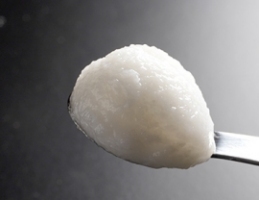
Cellulose Nanofibers: The Next Big ThingBy Mary Anne Hansan, President, Paper and Packaging Board Feb. 13, 2019 - The pulping process that turns wood into paper is an old technology. Really old. Older than eyeglasses. Older than the compass. Older than porcelain, gun powder, and even algebra. But what's remarkable is that, after nearly two millennia, our industry is still innovating around wood fiber, using cutting edge processes to transform it for use in brand new applications. We're making products that are lighter and stronger than their predecessors, and building natural, fully biodegradable materials that can replace fossil-fuel derived materials in many aspects of our lives. A big driver of that innovation is something called cellulose nanofibers, or nanocellulose. They come from the same wood pulp used to make paper and paper-based packaging, but are extracted from the pulp through heat, pressure, and grinding. The resulting fibers are teeny tiny. How teeny tiny? The average human hair is about 75 micrometers in width. That's 75 millionths of a meter. The average nanocellulose fiber is 15-30 nanometers in width. That's 20 billionths of a meter. It's also strong — with eight times the tensile strength of steel. Although scientists in the U.S. pioneered nanocellulose in the late 1970s and early 1980s, the world is only now starting to unlock its potential to improve our products and our lives.  In our own industry, nanocellulose is being added to paper to increase its strength and smoothness. It also shows huge promise as a way to improve paper-based packaging's air, water, and lipid barriers. Photo courtesy of Sappi.
In our own industry, nanocellulose is being added to paper to increase its strength and smoothness. It also shows huge promise as a way to improve paper-based packaging's air, water, and lipid barriers. Photo courtesy of Sappi.
In our own industry, nanocellulose is being added to paper to increase its strength and smoothness. It also shows huge promise as a way to improve paper-based packaging's air, water, and lipid barriers (a fancy way to describe the way cereal boxes keep your corn flakes from going stale, pizza boxes absorb grease, and coffee cups avoid getting soggy). The fibers can also be made into a transparent film similar in appearance to fossil-fuel derived plastics, a development that will have a big impact on the recyclability of packaging in the future. Nanocellulose can also be fabricated into foams and gels, and because it is completely non-toxic, that means it can even be used as stabilizers, flavor carriers and thickeners in food. Some manufacturers even see the potential for the use of nanofibers in building the next generation of lighter, stronger auto parts for super fuel-efficient cars. There is even research showing nanocellulose could replace the non-biodegradable and sometimes toxic substances used in making our cellphones and tablets. Biodegradable cell phones? How is that possible? Nanofibers can be biodegraded by a special kind of fungus, the organic matter that's left can go right back into the forests as raw material for growing trees. A couple thousand years after paper revolutionized the way the world communicated, paper could…revolutionize the way the world communicates. Now that's pulp magic. The Paper and Packaging Board promotes the use of paper products and paper-based packaging by highlighting the value they bring to our daily lives. The Paper & Packaging – How Life Unfolds® national marketing campaign shows how paper and packaging enhance business and personal productivity, creativity and learning and help protect and deliver the food and goods we want. To learn more, please visit: paperandpackaging.org. SOURCE: Paper and Packaging Board |
